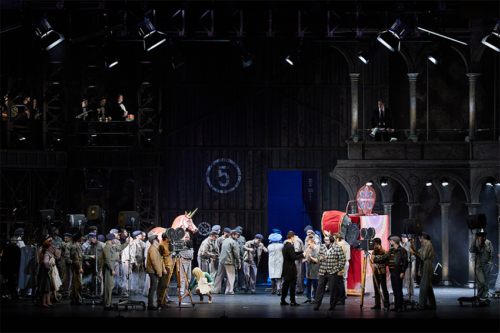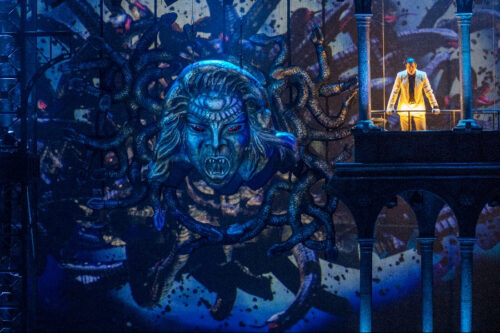 Russian Federation Berlioz, Benvenuto Cellini: Soloists, Dancers, Chorus and Orchestra of the Mariinsky Theatre / Valery Gergiev (conductor), Mariinsky II, 10.11.2021. (GT)
Russian Federation Berlioz, Benvenuto Cellini: Soloists, Dancers, Chorus and Orchestra of the Mariinsky Theatre / Valery Gergiev (conductor), Mariinsky II, 10.11.2021. (GT)

Production:
Stage direction – Alexey Frandetti
Set design – Vyacheslav Okunev
Costume design – Viktoria Sevryukova
Lighting design – Gleb Filshtinsky
Choreography – Irina Kashuba
Chorus masters – Konstantin Rylov and Pavel Teplov
Cast:
Benvenuto Cellini – Alexander Mikhailov
Tereza – Anastasia Kalagina
Ascanio – Evelina Agabalaeva
Fieramosca – Sergei Romanov
Giacomo Balducci – Oleg Sychev
Pope Clement VI – Stanislav Trofimov
Barkeeper – Oleg Balashov
Francesco – Oleg Losev
Bernandino – Yevgeny Chernyadyev
Cassandro – Dmitry Lunev
The Biscuit Man – Andrey Ushakov
The Dinosaur – Grigory Voilenko
Hector Berlioz was one of the major nineteenth century composers who successfully toured Russia during his years of fame and influenced both musical performance and composition there. Indeed, he dedicated this opera to Grand Duchess Maria Ivanovna when it was resurrected as an opera semiseria in Weimar in 1851 under Franz Liszt. Berlioz’s music is popular in Russia, but only very rarely have the operas been staged there. The first staging in Russia of Berlioz’s first opera Benvenuto Cellini was here at the Mariinsky Theatre on 6 June 2007 as part of the White Nights Festival. In the Salzburg Festival 2007 production, Valery Gergiev conducted the Vienna Philharmonic Orchestra. Again, under Gergiev, the Mariinsky Opera produced a critically acclaimed staging of Les Troyens which has toured widely throughout Europe.
The Russian musicologist Khristina Batyushina writes about the ideas behind this new staging by the Mariinsky Theatre: ‘Benvenuto Cellini, with its mass street scenes, and a drinking bout in a tavern, “Punch and Judy” theatre, and a Roman Catholic Pope as a deus ex machina and other effective circumstances, presents an alluring sphere of activity for any director of opera. The Moscow stage director Alexey Frandetti could see parallels between the story of the creation of the legendary statue of Perseus and the story of the filming of Federico Fellini’s cult film 8½. The director has transferred the plot of the opera to 1963, to a film studio in Rome where, as is well known, the greatest cinematic masterpiece of the twentieth century experienced a beginning laden with difficulties. The subjects are brilliantly laid out one after the other, because of crises and insights, the succession of procrastination and feverish activity, financial “swings” and relying on a client that accompany artistic creativity in any and every period.’
In an interview prior to the performance, Gergiev explained that ‘we decided to mount the production at the new Mariinsky II because of the huge technical potential of the theatre. A huge number of ideas and scenic effects by the stage producers can be fulfilled which can only please opera lovers.’ He added that ‘we have prepared several groups of singers and we are staging the opera four times in November. The singers have prepared very thoroughly, [and] in its size and length, the opera is difficult. Opera lovers can enjoy the famous scene of the Roman Carnaval, but I would not like to pick out separate episodes. Benvenuto Cellini is an essential and outstanding opera. I particularly love this composer.’
As the overture began, the curtains opened to show the director Benvenuto Cellini arriving at the Cinecittà film studio, reflecting on images from Fellini’s most famous films projected behind him. The studio’s producer, Clemente Medici, has commissioned him to make a film about Perseus. But Cellini is experiencing an artistic crisis and cannot fathom what this work should look like. We see a press conference attended by brightly dressed journalists and paparazzi with flashing cameras and microphones. Cellini meets Teresa, the daughter of Balducci who owns the film studio. Another director, Fieramosca, notes Teresa and Cellini’s mutual regard for one another. He draws Balducci’s attention to this, and the latter is incensed, and drives everyone out. This leads directly into Act I, Balducci is unhappy that the producer has invited Cellini from Florence to Rome and commissioned the blockbuster movie Perseus from him. In Balducci’s opinion, there is a better director in Rome – Fieramosca, who he wants his daughter to marry. But Teresa pays no heed to her father. The angry Balducci departs. From afar, mirthful singing can be heard as Cellini is celebrating with his friends. Teresa receives a love letter from Cellini.
Anastasia Kalyagina as Teresa sang a beautiful aria ‘Les belles fleurs’ and continues singing ‘Entre l’amour et le devoir’ while being lifted on a studio crane set against a beautiful starlit scene. Cellini now arrives and the two lovers sing an enchanting love duet. The Cellini of Alexander Mikhailov has a wonderful tenor voice and stage presence, and his fine recitative ‘O Teresa, vous que j’aime plus que ma vie’ was a highlight of the evening. Eagerly consumed with plans for an impending elopement, the lovers do not notice that Cellini’s rival Fieramosca has been eavesdropping on them. Unexpectedly, Balducci returns, and is beside himself with resentment: behind his back, Cellini has succeeded in arranging a date with Teresa. Furious, the director convenes all the women at the studio.
Act II opens in the film studio’s canteen where the staff have assembled: designers, cameramen, lighting technicians and actors. Among the actors are characters from Cowboy Westerns, Egyptian warriors, a character dressed as Elvis Pressley, and a golden horse. They wish to celebrate Cellini’s new opus, but Cellini’s wallet is empty, and the head of the canteen refuses to open a tab for him to obtain any wine. Cellini’s friend and pupil the young Ascanio comes to his rescue. He produces money he has received from Clemente. But there is a problem: the studio’s director Balducci has provided not much more than a modest sum. The angry designers resolve today to have their revenge on the curmudgeonly Balducci. During filming, Cellini with Ascanio’s assistance plan to abduct Teresa away from the old man. As planned, the friends will dress in monks’ costumes: Cellini in a white cassock and Ascanio in a brown one. This plan is overheard by Fieramosca. As soon as Cellini and his team leave the canteen, he hastens to come to an agreement with his friend, the drunkard and rough-neck Pompeo, on how to ruin the Florentine master’s idea. Fieramosca and Pompeo will dress in exactly the same costumes as Cellini and Ascanio, and together they will abduct Teresa.
All of the film studio’s staff have gathered to observe how the guest director will start work on his film. Work starts with a party marking the Roman Carnaval and concealed under masks, in the ensuing pantomime, Cellini’s friends engage in a routine in which they parody Fieramosca, Balducci and Clemente. Circus actors play and dance and create an extraordinarily colourful scene of acrobatics during which dancing, and frivolities surround everyone, Balducci swears revenge on those who have mocked him. Absorbed with this quarrel, he does not notice that his daughter Teresa has been taken away. Cellini and Ascanio hasten to help her. At the same time she is approached by Fieramosca and Pompeo; they are wearing similar masks and costumes. An argument erupts, which develops into a bitter fight, and Cellini accidentally kills Pompeo. The police arrest the culprit, but he wrestles free and makes his escape in the general confusion. The police set off after him, and Balducci grabs the disguised Fieramosca by mistake.

Act III opens in Cellini’s workshop – a mixing studio where Teresa and Ascanio await Cellini’s return. Cellini appears, having succeeded in eluding his pursuer, but suddenly Balducci enters. He showers his disobedient daughter with reproaches and declares that she is to be married today to Fieramosca, who has been released after declaring his innocence. The quarrel between Balducci and Cellini is interrupted by the arrival of Pope Clement who is drawn onstage in a bathtub together with his accompanying cardinals. He wants to know how the film is progressing. On hearing that Cellini has not even started work, the Pope becomes furious. But who, other than the great Cellini, can create Perseus? The director’s every sin will be forgiven if he starts filming right away. As a condition, Cellini demands Teresa’s hand in marriage to which Clemente and Balducci give their consent. All of those present accompany the producer, leaving only Ascanio in the mixing studio. He is worried, because stopping work on Perseus might also affect him. Ascanio prepares the film set and sings a merry song ‘Tra, la, la, la…’ accompanied by two guitar players. Cellini returns with a backdrop of a giant Medusa’s head projected behind him. As before, he does not know how to start work in his recitative, ‘Seul pour lutter’. His only wish is to run away with Teresa and go as far away as possible and packs a suitcase together with the film reels. At the same time, the patience of the studio staff is running out: they demand to be paid and refuse to work with Cellini. Even Teresa’s entreaties do not help. Suddenly Fieramosca appears. He attempts to ‘poach’ his competitor’s team but is given a stern refusal. Cellini forces Fieramosca to work on Perseus. Feverishly, the director starts working. At last the work is finished and the beautiful work of art is presented to the admiring audience, and the chorus jubilantly close with an image of Cellini’s Perseus now projected at the back, and the text ‘Finita la Commedia’ shining above the film studio.
This was a very colourful and enjoyable production of a complex opera which contains some of Berlioz’s finest music, orchestrally and vocally, and in this 1960s staging, Cinecittà is impressively recreated (by Vyacheslav Okunev) offering a realistic portrayal of Berlioz’s neglected masterpiece. The singing throughout was outstanding against a quickly moving plot with images projected onto the backdrop of movies such as King Kong, Charlie Chaplin, and many illusions to Hollywood and Italian cinema, during which we saw on stage a huge gorilla, a dinosaur, and a dancing girl suggesting Marilyn Monroe, with an illusion to Star Wars also in the fighting scene with Darth Vader’s lightsaber/sword used to kill Pompeo. A highlight was the acrobatics and highwire acts by circus actors bringing extra fun to the performance which was as much farce as it was serious. Of the singers, the Teresa of Anastasia Kalyagina was excellent with her amazingly, and often breathtaking high coloratura notes, while Alexander Mikhailov as Cellini was excellent in characterization and displayed his beautifully lyrical tenor, most notably in Act II, in the recitative, ‘Une heure encore’ majestically followed by the romance, ‘La gloire était ma seule idole’. The part of Balducci taken by the marvelously dark baritone Oleg Sychev was excellent. In the trousers role of Ascanio, Evelina Agabalaeva as Cellini’s apprentice, was excellent in her challenging role and quite superb in voice.
Above all, the orchestra and chorus under Valery Gergiev were magnificent in bringing this much overlooked music to the stage, and hopefully, when international touring restarts, we will see and enjoy this fine production on European stages.
Gregor Tassie
